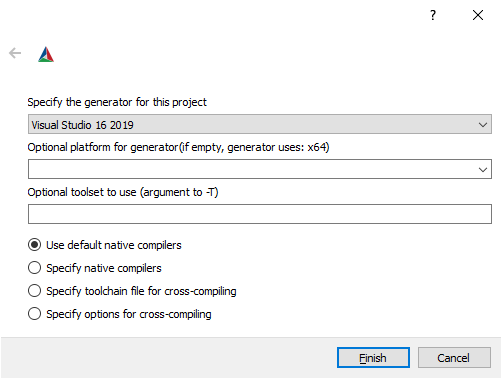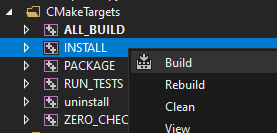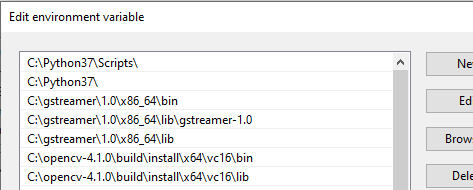GStreamer
Basic
OpenCV默认编译时没有开启对GStreamer的支持,需要自行编译OpenCV,并开启对GStreamer的支持(WITH_GSTREAMER=ON),如果想在Python中使用,还需要特别指定Python的相关路径
cmake -D CMAKE_BUILD_TYPE=RELEASE -D CMAKE_INSTALL_PREFIX=/usr/local -D INSTALL_PYTHON_EXAMPLES=ON -D INSTALL_C_EXAMPLES=OFF -D PYTHON_EXECUTABLE=$(which python) -D BUILD_opencv_python2=ON -D CMAKE_INSTALL_PREFIX=$(python2 -c "import sys; print(sys.prefix)") -D PYTHON_EXECUTABLE=$(which python) -D PYTHON_INCLUDE_DIR=$(python -c "from distutils.sysconfig import get_python_inc; print(get_python_inc())") -D PYTHON2_PACKAGES_PATH=/opt/ros/kinetic/lib/python2.7/dist-packages -D WITH_GSTREAMER=ON -D OPENCV_GENERATE_PKGCONFIG=ON -D BUILD_EXAMPLES=ON ..-
多个视频源时,根据显示画面的问题进行debug(假设有在两个视频源A与B中进行切换) 检查要点:长、宽以及帧率必须一致
错误效果 原因 从A切换至B时卡住,在切换回A中出现严重延迟 两个VideoWriter使用的画面尺寸相同,端口不同,只向所选择的视频源的端口写入 在A与B之间的切换过程中有极大的延迟 两个VideoWriter使用的画面尺寸相同,端口相同,只向所选择的视频源的端口写入 卡住,出现绿屏等 两个VideoWriter使用的画面尺寸不同,端口相同,只向所选择的视频源的端口写入 Solution result Two VideoWriter, same size, different port, only write to the port that selected Will stuck, causing huge delay when switch back Two VideoWriter, same size, same port, only write to the port that selected Huge delay or stuck when switching between video source Two VideoWriter, different size, same port, only write to the port that selected Stuck, green screen, etc -
用GStreamer自带的工具查看视频源信息
gst-device-monitor-1.0 Video/Source
-
打开多个视频设备并传输
import threading
import cv2
import os
import numpy as np
class videoThread(threading.Thread):
def __init__(self, threadID, name, ip_addr):
threading.Thread.__init__(self)
self.threadID = threadID
self.name = name
self.t = 0
self.width = 1920
self.height = 540
my_cmd = os.popen('v4l2-ctl --list-devices').read()
my_cmd = my_cmd.split('\n')
dev_webcam = []
for idx, val in enumerate(my_cmd):
if 'UVC' in val:
dev_webcam.insert(0, my_cmd[idx + 1].replace('\t', ''))
print 'Logitech Cam is ' + dev_webcam[0]
elif 'Pana' in val:
dev_pana = my_cmd[idx + 1].replace('\t', '')
print 'PanaCast is ' + dev_pana
self.cap_webcam = []
self.cap_pana = cv2.VideoCapture(
'v4l2src device=' + dev_pana + ' ! image/jpeg,width=1920,height=1080,framerate=30/1 ! decodebin ! videoconvert ! appsink')
fps = self.cap_pana.get(cv2.CAP_PROP_FPS)
print 'v4l2src device=' + dev_pana
print "Frames per second using video.get(cv2.cv.CV_CAP_PROP_FPS): {0}".format(fps)
self.cap_webcam.append(cv2.VideoCapture(
'v4l2src device=' + dev_webcam[0] + ' ! image/jpeg,width=960,height=544,framerate=30/1 ! decodebin ! videoconvert ! appsink'))
fps = self.cap_webcam[0].get(cv2.CAP_PROP_FPS)
print 'v4l2src device=' + dev_webcam[0]
print "Frames per second using video.get(cv2.cv.CV_CAP_PROP_FPS): {0}".format(fps)
self.cap_webcam.append(cv2.VideoCapture(
'v4l2src device=' + dev_webcam[1] + ' ! image/jpeg,width=960,height=544,framerate=30/1 ! decodebin ! videoconvert ! appsink'))
fps = self.cap_webcam[1].get(cv2.CAP_PROP_FPS)
print 'v4l2src device=' + dev_webcam[1]
print "Frames per second using video.get(cv2.cv.CV_CAP_PROP_FPS): {0}".format(fps)
#self.out_send = cv2.VideoWriter(
#'appsrc ! videoconvert ! \
# tee name="local" ! queue ! jpegenc! \
# rtpjpegpay ! udpsink host=' + ip_addr +' port=5000 sync=false local. ! queue ! autovideosink',
#cv2.CAP_GSTREAMER, 0, 25, (self.width, self.height), True)
self.out_send = cv2.VideoWriter(
'appsrc ! videoconvert ! \
tee name="local" ! queue ! jpegenc! \
rtpjpegpay ! udpsink host=' + ip_addr +' port=5000 sync=false local. ! queue ! autovideosink',
cv2.CAP_GSTREAMER, 0, 25, (self.width, self.height), True)
if not self.cap_webcam[0].isOpened() or not self.cap_webcam[1].isOpened or not self.cap_pana.isOpened() or not self.out_send.isOpened():
print('VideoCapture or VideoWriter not opened')
exit(0)
self.running = True
def run(self):
flag = 0
while self.running:
if flag == 0:
ret, p_frame = self.cap_pana.read()
frame = p_frame[268:p_frame.shape[0] - 272, 0:p_frame.shape[1]]
self.out_send.write(frame)
elif flag == 1:
ret, w_frame = self.cap_webcam[0].read()
black = np.zeros((self.height, 480, 3), np.uint8)
frame = np.concatenate((black, w_frame[2:w_frame.shape[0] - 2, 0:w_frame.shape[1]], black), axis=1)
self.out_send.write(frame)
elif flag == 2:
ret, w_frame = self.cap_webcam[1].read()
black = np.zeros((self.height, 480, 3), np.uint8)
frame = np.concatenate((black, w_frame[2:w_frame.shape[0] - 2, 0:w_frame.shape[1]], black), axis=1)
self.out_send.write(frame)
if not ret:
print('empty frame')
break
cv2.imshow('send', frame)
key = cv2.waitKey(1)
if key & 0xFF == ord('q'):
break
elif key & 0xFF == ord('s'):
if flag == 0:
flag = 1
elif flag == 1:
flag = 2
else:
flag = 0
self.running = False
self.cap_pana.release()
self.cap_webcam[0].release()
self.cap_webcam[1].release()
self.out_send.release()
cv2.destroyAllWindows()
threading.Thread.exit()
if __name__ == '__main__':
ip_addr = '130.215.206.182'
v_thread = videoThread(0, 'videoT', ip_addr)
v_thread.start()Windows下配置GStreamer+Python+OpenCV
参考来源:How to compile OpenCV with Gstreamer [Ubuntu&Windows]
-
Install both gstreamer-runtime and gstreamer-development package in the same location 执行完整安装(full install)
-
Download opencv release sources (.zip file) and extract.
-
Add gstreamer to Path variable

-
Add system variable “GSTREAMER_DIR” “C:\gstreamer\1.0\x86_64”

-
CmakeGUI & Visual Studio
- install CmakeGUI 3.14.5 CmakeGUI >> https://cmake.org/download/
- Open CmakeGUI.
- Select opencv source and build folder.

- Hit Configure, select your Visual Studio version then click Finish

注意编译器选择和x64选择
-
Click Configure again, The red value will change to white.
-
Click Generate
-
Click “Open Project”
-
In Visual Studio: switch from DEBUG to RELEASE and x64 Otherwise there will be an error: couldn’t find python27_d.lib
-
Right click on INSTALL and select Build

-
Finally, add bin & lib folder to PATH, located in C:\opencv-4.1.0\build\install\x64\vc16


-
Test code
import cv2
cap = cv2.VideoCapture('ksvideosrc ! video/x-raw, framerate=30/1, width=640, height=480 ! videoconvert ! appsink')
while True:
ret,frame = cap.read()
cv2.imshow('',frame)
if cv2.waitKey(1) & 0xFF == ord('q'):
break
cv2.destroyAllWindows()
cap.release()
